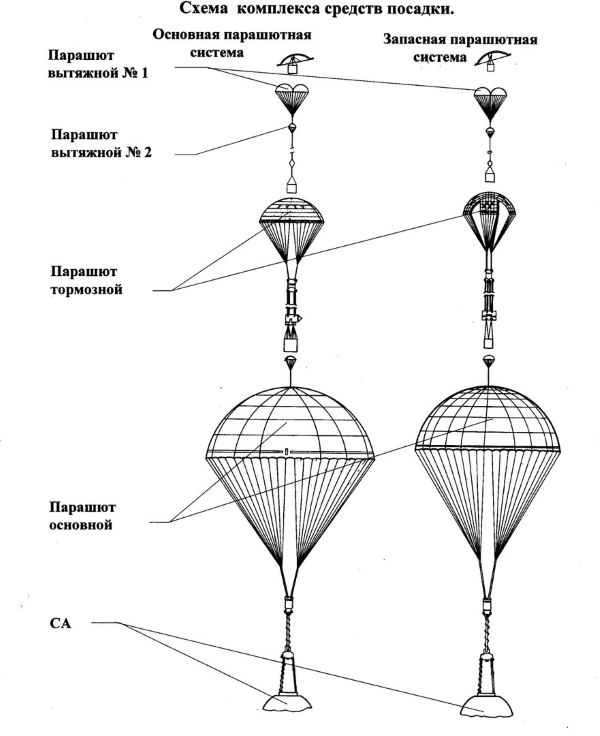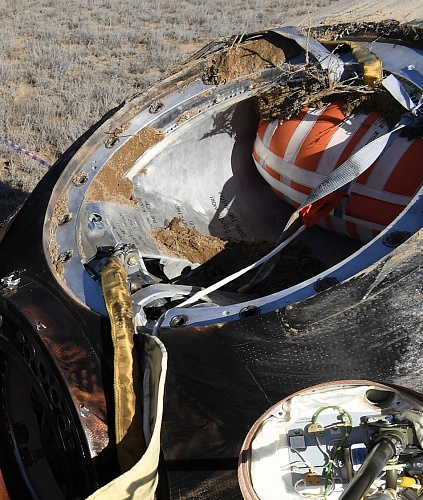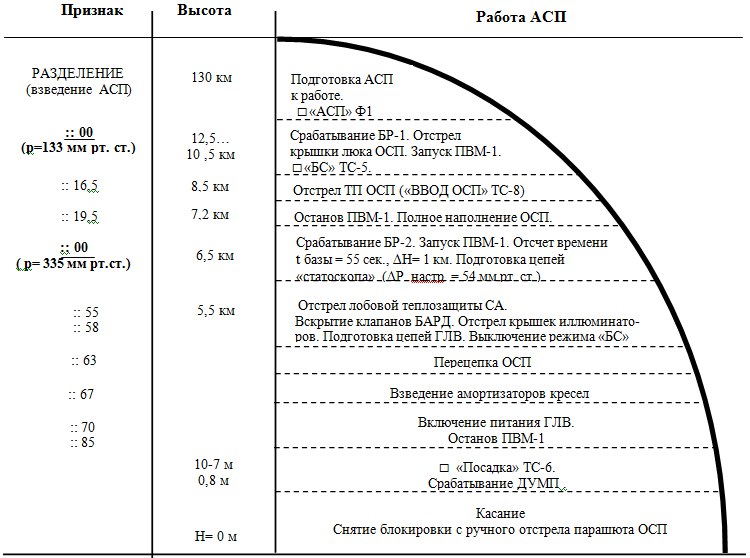Honest technology and incomprehensible people in the history of the depressurization of the "Union"
A noticeable news last week was the press conference of the Advisory Committee on the ISS on October 16. It was announced that during the landing process of the Soyuz spacecraft a partial depressurization of the descent vehicle occurred. How dangerous was that? Do such incidents often occur? And what could be the reason for such a press conference?

The same landing on April 10, photo by NASA / Bill Ingalls
During the landing of the Soyuz MS-02 spacecraft at the time of opening the main parachute, a detail of the parachute system struck the wall of the parachute container, which caused a crack of 3.5 centimeters in size, through which air leakage began. Different sources differ on the definition of the “culprit”. According to the magazine "Astronautics News" this is a swivel - a part that prevents twisting of the lines and parachute cables, but according to the representative of RSC Energia, the reason was the buckle of the brake parachute. The press service of Roscosmos reported that the incident is random, and measures to prevent its recurrence have already been taken.
Parachute system of the ship "Soyuz" consists of exhaust, brake, main and reserve parachutes.

The parachute attachment system for the descent vehicle looks like this:

Source: Cosmonautics News magazine
Swivel close-up:

A source
There are no signs of a crack in the available photos of the parachute compartment.


Full size photo
In the general case, the depressurization of a spacecraft is a very dangerous thing, and already once led to the death of astronauts on the Soyuz-11, but specifically in this case, the danger was minimal. First of all, after the bitter experience of the Soyuz-11, astronauts perform potentially dangerous operations (start, docking, landing) in space suits. Further, the accident occurred at a time when the descent vehicle was already in the dense layers of the atmosphere. The main parachute begins to open at an altitude of 10.5 km, but during its full disclosure, the ship has time to drop by three kilometers.

The landing of the ship "Soyuz"
Even if the hole would be many times larger (otherwise the air flows out too slowly), and the crew would be without spacesuits, nothing terrible would threaten them. In the end, with a normal landing just two kilometers below the breather valve opens, equalizing the pressure inside and outside. And finally, since the incident was connected with the algorithm for disclosing the main parachute, it could not happen in orbit.
The official statement of Roskosmos says that “all operations on descent from orbit and landing proceeded normally”. Someone might think that they tried to hide this accident from us, but this is not so. The incident was described in No. 6 of the Cosmonautics News magazine for this year, to which anyone can subscribe. And blaming the press service of Roskosmos for not mentioning the accident is not worth it. The fact is that any space mission of any country is confronted with a mass of various minor incidents that did not interfere with the execution of the flight program and are usually only interesting for specialists and enthusiasts of astronautics. For example, on the same day, April 10, there was another incident at Soyuz MS-02 - after the ship was disconnected from the ISS, an increased partial pressure of oxygen was detected on it (26%, 1.23 times higher than the norm). At the beginning of this year, in preparation for the launch of Soyuz MC-04, one of the valves was detected as leaking. On November 19, at the Soyuz MS-03, an angular velocity sensor crash occurred on the 14th orbit of the flight, disrupting the construction of the test orientation in the orbital coordinate system. The start of Soyuz MS-02 was postponed due to a clamped cable. The docking of Soyuz TMA-19M on December 15, 2015 was complicated by the problem with the orientation engine. On March 19, 2016, the Soyuz TMA-20M had to switch to backup equipment Kurs-A due to the unstable operation of the main kit. And this is only the last two years. Other countries are doing the same thing. Attentive reading of flight histories, for example, shuttles, shows the same abundance of minor accidents - two on-board computers failed at STS-135, the STS-134 was postponed due to the failure of the auxiliary power unit heater and so on. So if a regular flight were considered to be the absence of problems at all, such flights would happen once every several decades.
An alarming sign would be an increase in the potential hazard of accidents. But this is not observed. Since the beginning of the 21st century, the most serious wrecks of the Union were in 2007–2008, when, due to the failure of one of the pyrobolts, there was no complete separation of the descent vehicle and the aggregate compartment, due to which the first one entered the atmosphere “upside down”. At the top, the layer of thermal protection is thinner, so the Soyuz TMA-10M and Soyuz TMA-11M were in grave danger. Fortunately, the Soyuz spacecraft was designed very well, the aggregate compartment was burning off and falling off before the upper thermal protection resource was running out, and then the descent vehicle was oriented correctly under its own weight.

Burnt pitch engine "Soyuz TMA-11M", photo of the magazine "Astronautics News"
The next ship's Pyrobolt, the Soyuz TMA-12M, was also under suspicion, so it was removed at one of the spacewalks. But they managed to solve the problem, such incidents did not recur, and over the past ten years there have been no equally dangerous accidents. There is no reason for panic, but you shouldn’t be complacent either - space technology is complex, and the dangers of space are absolutely real. Only the quality of design and performance of work can prevent truly dangerous problems.
A separate question is, why does this story make a fuss at all? Alas, the work of technology is simpler and clearer than what people are doing, and instead of a clear answer, I have to give a list of possible versions.
"The Prophet in a foreign country . " Domestic media do not read the Cosmonautics News magazine, therefore the content of the press conference, retold on SpaceNews, was news for them. This version is supported by the fact that in the Western media there is not much interest in this story, but the domestic publications have been reprinting it quite actively.
"Constructive paranoia . " Space agencies have different approaches to the organization of manned flights, and some events may be perceived by NASA more sharply than by Roscosmos. For example, the Soyuz and the ISS have meteor defense panels that were added at the request of NASA, but are considered to be excessive Roscosmos. NASA controls the creation of several manned spacecraft, and the safety of the crew is logical for it, so this story can be used as an example to increase the reliability of its own ships.
"Political intrigue . " The above-mentioned source SpaceNews speaks of doubts about the reliability of Russian ships, but since this is not indicated as a quote, it is more likely that this is the opinion of the journalist who wrote the material. It remains to hope that the committee has not taken a biased position and is not trying to make Russian ships less reliable and more dangerous than they are. In the not so distant future, NASA will stop buying places on the "Unions", and this is normal, the main issue is future cooperation. The statement on cooperation between Roscosmos and NASA published at the 68th International Astronautical Congress was great news, and now it would be very sad to see the force lobbying to reject it. Today, large space projects of the country can only be created together, and the more participants in the project of the Deep Space Gateway station in the lunar orbit, the larger and more functional it will be.

The same landing on April 10, photo by NASA / Bill Ingalls
What exactly happened?
During the landing of the Soyuz MS-02 spacecraft at the time of opening the main parachute, a detail of the parachute system struck the wall of the parachute container, which caused a crack of 3.5 centimeters in size, through which air leakage began. Different sources differ on the definition of the “culprit”. According to the magazine "Astronautics News" this is a swivel - a part that prevents twisting of the lines and parachute cables, but according to the representative of RSC Energia, the reason was the buckle of the brake parachute. The press service of Roscosmos reported that the incident is random, and measures to prevent its recurrence have already been taken.
Materiel
Parachute system of the ship "Soyuz" consists of exhaust, brake, main and reserve parachutes.

The parachute attachment system for the descent vehicle looks like this:

Source: Cosmonautics News magazine
Swivel close-up:

A source
There are no signs of a crack in the available photos of the parachute compartment.


Full size photo
How dangerous was that?
In the general case, the depressurization of a spacecraft is a very dangerous thing, and already once led to the death of astronauts on the Soyuz-11, but specifically in this case, the danger was minimal. First of all, after the bitter experience of the Soyuz-11, astronauts perform potentially dangerous operations (start, docking, landing) in space suits. Further, the accident occurred at a time when the descent vehicle was already in the dense layers of the atmosphere. The main parachute begins to open at an altitude of 10.5 km, but during its full disclosure, the ship has time to drop by three kilometers.

The landing of the ship "Soyuz"
Even if the hole would be many times larger (otherwise the air flows out too slowly), and the crew would be without spacesuits, nothing terrible would threaten them. In the end, with a normal landing just two kilometers below the breather valve opens, equalizing the pressure inside and outside. And finally, since the incident was connected with the algorithm for disclosing the main parachute, it could not happen in orbit.
Emergency weekdays
The official statement of Roskosmos says that “all operations on descent from orbit and landing proceeded normally”. Someone might think that they tried to hide this accident from us, but this is not so. The incident was described in No. 6 of the Cosmonautics News magazine for this year, to which anyone can subscribe. And blaming the press service of Roskosmos for not mentioning the accident is not worth it. The fact is that any space mission of any country is confronted with a mass of various minor incidents that did not interfere with the execution of the flight program and are usually only interesting for specialists and enthusiasts of astronautics. For example, on the same day, April 10, there was another incident at Soyuz MS-02 - after the ship was disconnected from the ISS, an increased partial pressure of oxygen was detected on it (26%, 1.23 times higher than the norm). At the beginning of this year, in preparation for the launch of Soyuz MC-04, one of the valves was detected as leaking. On November 19, at the Soyuz MS-03, an angular velocity sensor crash occurred on the 14th orbit of the flight, disrupting the construction of the test orientation in the orbital coordinate system. The start of Soyuz MS-02 was postponed due to a clamped cable. The docking of Soyuz TMA-19M on December 15, 2015 was complicated by the problem with the orientation engine. On March 19, 2016, the Soyuz TMA-20M had to switch to backup equipment Kurs-A due to the unstable operation of the main kit. And this is only the last two years. Other countries are doing the same thing. Attentive reading of flight histories, for example, shuttles, shows the same abundance of minor accidents - two on-board computers failed at STS-135, the STS-134 was postponed due to the failure of the auxiliary power unit heater and so on. So if a regular flight were considered to be the absence of problems at all, such flights would happen once every several decades.
Trends
An alarming sign would be an increase in the potential hazard of accidents. But this is not observed. Since the beginning of the 21st century, the most serious wrecks of the Union were in 2007–2008, when, due to the failure of one of the pyrobolts, there was no complete separation of the descent vehicle and the aggregate compartment, due to which the first one entered the atmosphere “upside down”. At the top, the layer of thermal protection is thinner, so the Soyuz TMA-10M and Soyuz TMA-11M were in grave danger. Fortunately, the Soyuz spacecraft was designed very well, the aggregate compartment was burning off and falling off before the upper thermal protection resource was running out, and then the descent vehicle was oriented correctly under its own weight.

Burnt pitch engine "Soyuz TMA-11M", photo of the magazine "Astronautics News"
The next ship's Pyrobolt, the Soyuz TMA-12M, was also under suspicion, so it was removed at one of the spacewalks. But they managed to solve the problem, such incidents did not recur, and over the past ten years there have been no equally dangerous accidents. There is no reason for panic, but you shouldn’t be complacent either - space technology is complex, and the dangers of space are absolutely real. Only the quality of design and performance of work can prevent truly dangerous problems.
Motives
A separate question is, why does this story make a fuss at all? Alas, the work of technology is simpler and clearer than what people are doing, and instead of a clear answer, I have to give a list of possible versions.
"The Prophet in a foreign country . " Domestic media do not read the Cosmonautics News magazine, therefore the content of the press conference, retold on SpaceNews, was news for them. This version is supported by the fact that in the Western media there is not much interest in this story, but the domestic publications have been reprinting it quite actively.
"Constructive paranoia . " Space agencies have different approaches to the organization of manned flights, and some events may be perceived by NASA more sharply than by Roscosmos. For example, the Soyuz and the ISS have meteor defense panels that were added at the request of NASA, but are considered to be excessive Roscosmos. NASA controls the creation of several manned spacecraft, and the safety of the crew is logical for it, so this story can be used as an example to increase the reliability of its own ships.
"Political intrigue . " The above-mentioned source SpaceNews speaks of doubts about the reliability of Russian ships, but since this is not indicated as a quote, it is more likely that this is the opinion of the journalist who wrote the material. It remains to hope that the committee has not taken a biased position and is not trying to make Russian ships less reliable and more dangerous than they are. In the not so distant future, NASA will stop buying places on the "Unions", and this is normal, the main issue is future cooperation. The statement on cooperation between Roscosmos and NASA published at the 68th International Astronautical Congress was great news, and now it would be very sad to see the force lobbying to reject it. Today, large space projects of the country can only be created together, and the more participants in the project of the Deep Space Gateway station in the lunar orbit, the larger and more functional it will be.
All Articles